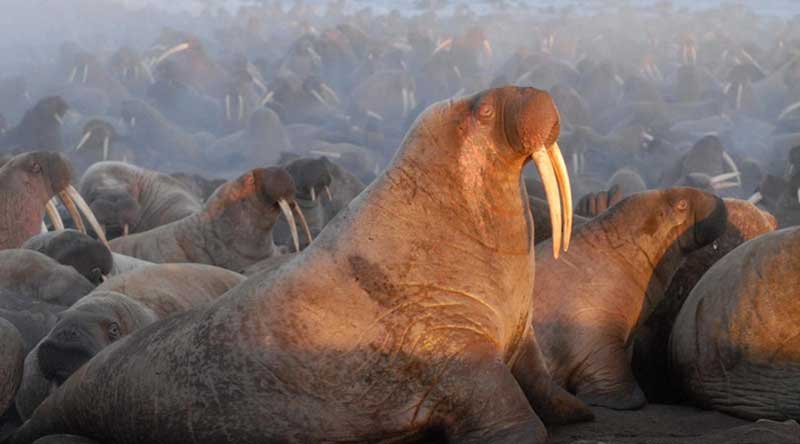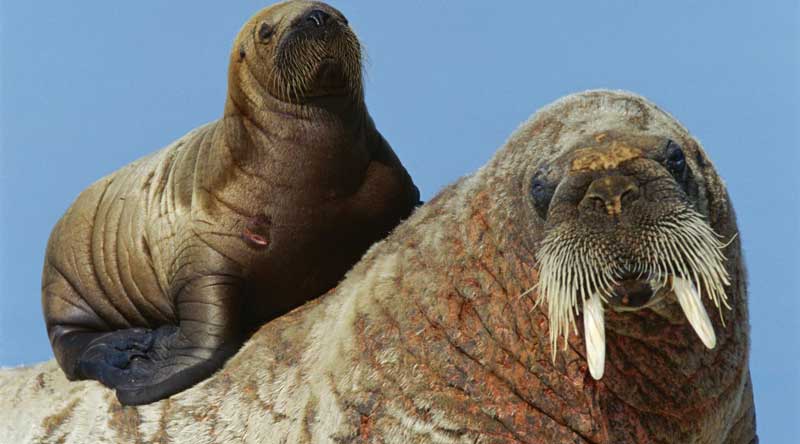
With wrinkled brown and pink hides, along with the distinctive features of long white tusks, grizzly whiskers, flat flipper, and massive fusiform bodies full of blubber, the Walruses are unmistakably one of the most majestic and recognizable animals in the Arctic. They have no external ears, and the absence of orbital roofs allow it to protrude its small eyes and see in both a frontal and dorsal direction, although its vision appears to be more suited for short-range. Its muzzle is short and broad and has a conspicuous mustache of stiff, quill-like whiskers, known as vibrissae. The fore and hind limbs of a walrus are modified into flippers, and while the fore flippers are short and square in shape with tiny claws on all digits, the hind flippers are triangular in shape with larger claws on the three middle digits. Like the sea lions, walruses are capable of rotating their hind flippers under their pelvic girdle to walk on all fours on land.

The long-tusked and mustached walrus is most often found near the Arctic Circle, lying on the ice with hundreds of companions. Their iconic long tusks, present in both male and female, are elongated canines that can reach about three feet (1 m) and weigh around 5`5 kg.
The tusks are slightly longer and thicker among the males, which use them aggressively for fighting during the mating season for fighting against other bulls for dominance over the female. Tusks are also used to haul their enormous bulk out of the frigid water, and also to break breathing holes in the ice from below. Contrary to the traditional belief that the tusks are used to dig out prey from the seabed, the analyses of abrasion patterns on the tusks indicate they are dragged through the sediment while the upper edge of the snout is used for digging. Rooting along the ocean floor with its snout, it identifies prey with its whiskers, attached to muscles and are supplied with blood and nerves, making them highly sensitive organs.

Under its throat, the walrus has an air sac that acts as a floatation bubble and allows it to bob vertically in the water and sleep. The males have a large penis bone, known as baculum, which can be 25 inches (63 cm) long, the largest of any land mammal, both in absolute size and relative to body size.
Under their highly wrinkled and thick skin, they have 6 inches (15 cm) blubber layer, which is instrumental for their huge body weight and keep them warm, while the fat provides them energy. In the wild, walrus can live for around 40 years.

The walruses are not particularly deep divers and feed at depths of less than 260 feet (80 m), and usually at 30 to 160 feet (10 to 50 m). Their diet includes crabs, shrimp, tube worms, soft corals, and various mollusks. They suck the meat out by sealing its powerful lips and withdrawing its tongue rapidly into its mouth.

The two subspecies of walrus are known as the Atlantic walruses that inhabit coastal areas from northeastern Canada to Greenland, and the Pacific walruses inhabit the northern seas off the coast of Russia and Alaska. However, in late spring and summer, several hundred thousand Pacific walruses migrate from their southern range in the Bering Sea to the Chukchi Sea through the relatively narrow Bering Strait.
The female Pacific walruses give birth to calves during this spring migration to the north. Except for some outsized Pacific males weighing as much as 2,000 kg (4,400 lb), most weigh between 800 and 1,700 kg. However, the male Atlantic walrus, with relatively shorter tusks and somewhat more flattened snout, weigh an average of 900 kg. In both the subspecies, the females weigh about two-thirds as much as the males.

While the female walruses begin ovulating as soon as four to six years old, the males reach sexual maturity at seven, but do not typically mate until fully developed at around 15 years of age. The males mate with multiple females in winter and display by showing their tusks and making clicking and bell-like sounds underwater. When a female is attracted, she joins the male and copulates underwater. Delayed implantation of the fertilized egg results in a total gestation of 15 to16 months and calves are born during the spring migration, from April to June. The single walrus pup weighs about 60 kg at birth and although the mother nurses her baby for over a year before weaning, it remains with the mother for two to three years.